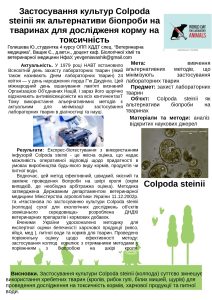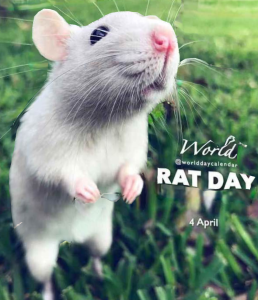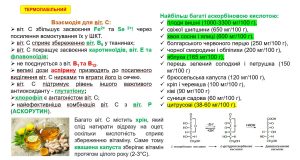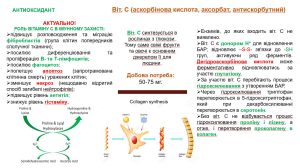ON APRIL 28, THE WORLD CELEBRATES BIOLOGICAL CLOCK DAY!
📍The tradition of celebrating this holiday comes from the United States. The history of its foundation is unknown, but the day is of great value, forcing people to listen to their bodies.
The Day of the Biological Clock demonstrates the complex relationship between our internal circadian rhythms and the outside world. This holiday emphasizes the profound impact our biological clocks have on our sleep patterns, mood, metabolism, and overall health, calling for a deeper understanding and respect for these internal timekeepers.
The circadian rhythm (biological clock) is a daily phase of activity that repeats itself. It is needed to regulate sleep, wakefulness, eating behavior, hormone levels, and other processes. The regulation of the circadian rhythm is influenced by the concentration of hormones at different times of the day and genetic mechanisms.
📍Our circadian rhythms, 24-hour cycles that are part of the body’s internal clock, play a crucial role in determining sleep and wakefulness. Controlled by the brain’s master clock, these rhythms depend on environmental cues – primarily light and darkness – and thus dictate not only sleep patterns, but also nutrition, hormone release, body temperature, and other vital bodily functions.
⚡️The causes of biological rhythm disruption can be various: working at night or during the day, a sharp change in time zones, sleep deprivation, and eating disorders.
⚡️ The concept of biological rhythms goes back centuries, and references to them can be found in ancient Greek texts.
⚡️ Modern scientific research began in the late 19th and early 20th centuries and culminated in the discovery of the “clock genes” that control these rhythms. These genes ensure that our physiological processes are synchronized with the day-night cycle, optimizing health and functioning.
SAVE THE FROGS DAY
Save the Frogs Day is an annual event that takes place on April 28th and aims to raise awareness of the importance of amphibian conservation and the threats facing frog populations around the world.
This event is created and coordinated by SAVE THE FROGS! Since 2009, activists and volunteers of this organization have been conducting educational events around the world, providing educational materials for those who want to join this environmental campaign.
World Frog Day is the world’s largest day of amphibian awareness and conservation. Since its inception in 2009, this global event has inspired individuals, communities, and organizations in 58 countries to raise awareness of the critical threats facing amphibian populations and take meaningful steps to protect them.
⚡️ Amphibians, including frogs, salamanders, newts, and pygmy frogs, are among the most endangered animal groups on the planet. These fascinating creatures play a crucial role in ecosystems as predators and prey, contributing to pest control and serving as indicators of environmental health. However, they are facing unprecedented challenges and threats from habitat destruction, pollution, climate change, invasive species and disease.
⚡️ The impact of World Frog Day goes beyond a single day, as it aims to instill a lasting commitment to environmental stewardship and amphibian conservation. By creating a global community of aware and active citizens, the initiative hopes to halt the decline of amphibian populations and ensure a healthy planet for future generations.
📍Action Day embodies the collective power of individual action to address one of the most pressing conservation issues of our time. By participating in this global movement, each of us can contribute to a wave of positive change in environmental protection.
This day is a reminder of the crucial role that frogs play in maintaining healthy ecosystems and highlights the urgent need for action to protect these vulnerable species.
WORLD DAY FOR THE PROTECTION OF LABORATORY ANIMALS
(WORLD DAY FOR LABORATORY ANIMALS)
Every year on April 24, the world celebrates the Day for the Protection of Laboratory Animals. The purpose of this day is to draw the world’s attention to the moral and ethical problems of conducting laboratory research and experiments on live animals that experience pain, fear, discomfort, and other suffering.
Who are the experiments conducted on?
Animals of various species are used for experiments. Most often, rats, mice, primates, dogs, cats, rabbits, and frogs are used as objects of experimentation. Flies, worms, and other insects are also used. Most of these animals are specially bred for experiments or transferred from animal shelters, while some wild species are captured for these purposes from the wild.
But what about legislation?
Back in 1959, three basic principles were developed for the use of animals in research:
- Replacement of animal research methods with methods that exclude the use of animals (for example, computer modeling methods) if this allows achieving the same research results. At the same time, methods of conducting research without the use of animals should be given preference.
- Preference should be given to methods that allow obtaining the necessary information from experiments on fewer animals or more information from experiments on the same number of animals.
- Improving methods that alleviate or minimize potential pain, suffering, and debilitation of animals and improve the welfare of animals used in research.
The national legislation of Ukraine operates with the concept of “experimental animal” and allows the use of these animals in scientific experiments, biological testing, and the educational process only if there is no possibility of replacing them with other alternative methods and objects, and only if there is a permit for experimental research on the animal. In addition, procedures that pose a risk of injury to animals or cause acute or prolonged painful stimuli shall be performed only under anesthesia.
It is prohibited to involve animals that cannot tolerate captivity, confined spaces, or training in experiments. It is also forbidden to deprive animals of the ability to make sounds by surgery and to use traumatic methods when taking cells from animals.
However, despite these legislative norms, the animal somehow experiences pain and suffering, and its entire life is spent in the rhythm of experiments and interventions in the body, which leads to further death or euthanasia.
Testing cosmetics on animals in Ukraine
Since 2013, the European Union has completely banned cosmetics tested on animals.
In July 2019, the Ministry of Health of Ukraine initiated a discussion on strengthening the requirements for cosmetic products and banning animal testing as part of the preparation of the Cosmetics Regulation, developed on the basis of EU Regulation No. 1223/2009.
“This is particularly relevant to the prohibition of animal testing of cosmetics and the transition to the latest te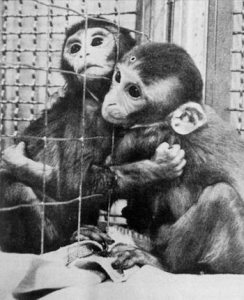 chnological developments, including alternative methods of testing cosmetic products. Currently, Ukraine has no approved methodologies for alternative safety testing of cosmetics. The transitional period will allow the Ukrainian cosmetics business to develop without obstacles,” the statement said.
chnological developments, including alternative methods of testing cosmetic products. Currently, Ukraine has no approved methodologies for alternative safety testing of cosmetics. The transitional period will allow the Ukrainian cosmetics business to develop without obstacles,” the statement said.
In order to adopt a ban on animal testing of cosmetics, a draft resolution of the Cabinet of Ministers “On Approval of the Technical Regulations for Cosmetic Products” was developed. We hope that this ban will be adopted soon.
It should be noted that on September 01, 2021, the sculptural composition “The Phenomenon of Health Sciences” was unveiled on the territory of the National University of Pharmacy in preparation for the 100th anniversary. The Rector of the National University of Pharmacy Alla Kotvitska noted that “this sculptural composition symbolizes the gratitude of mankind to laboratory animals for their contribution to scientific discoveries, and was the first in Ukraine. Laboratory animals have been ideal assistants to scientists for many decades. Today, the scientific community is rethinking approaches to scientific research, starting to apply the latest technologies: bioengineering, three-dimensional modeling, cell cultures.”
The Educational and Research Institute of Applied Pharmacy and the Department of Biological Chemistry and Veterinary Medicine join the celebration of the important event and offer to view posters submitted by students, teachers and researchers from Ukraine, Georgia and the Republic of Lithuania.
The authors of the best reports in terms of content and relevance were awarded.
1st Degree Diploma:
– El Assri Abdeladim, Beri Zakaria, Sekkat Amane Allah: “Animal experiments: a historical perspective” (Kingdom of Morocco).
– Vadym Galuzinskyi, Dmytro Lytkin, Julija Razumiene: “Invertebrate laboratory animals as an alternative to vertebrates” (Ukraine, Republic of Lithuania).
– Eva Gros, Volodymyr Kushnir: “Modern technologies as an alternative to live laboratory animals” (Ukraine).
Diploma of the 2nd Degree:
– Igor Seniuk, Vira Kravchenko, Nodar Sulashvili: “Culture of laboratory animal care” (Ukraine, Georgia).
– Daria Hnatenko: “Alternatives to experiments on laboratory animals” (Ukraine).
– Daria Tyunina: “Mercy or murder? Discussion on the euthanasia of laboratory animals” (Ukraine).
Diploma of the 3rd Degree:
– Yelyzaveta Avramenko: “Laboratory animals in the educational process” (Ukraine).
– Polina Bogomolova: “Protection of laboratory animals” (Ukraine).
– Bogdan Sokolov, Daniel Pandas: “The global role of amphibians in the educational process” (Ukraine).
– Daria Koval: “The use of laboratory animals in cosmetics testing” (Ukraine).
POSTER REPORTS
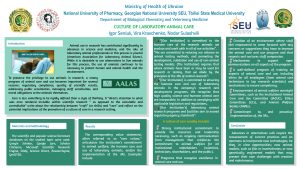 2.
2. 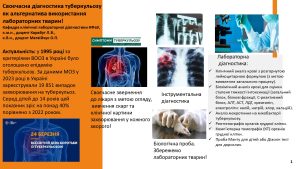 3.
3.  4.
4. 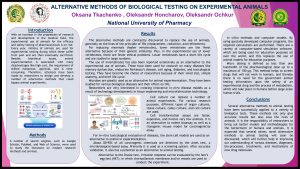 5.
5.  6.
6. 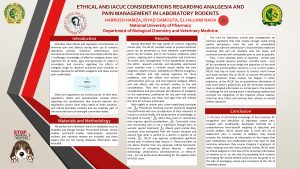
13 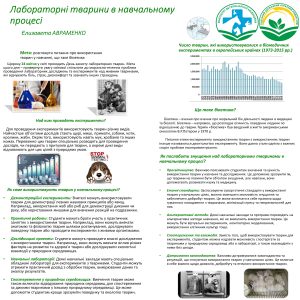 14.
14. 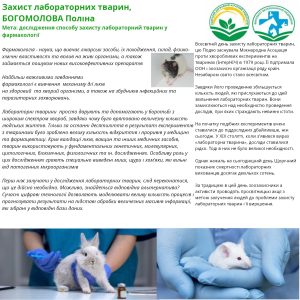 15.
15. 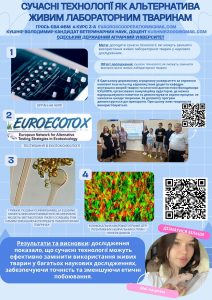 16
16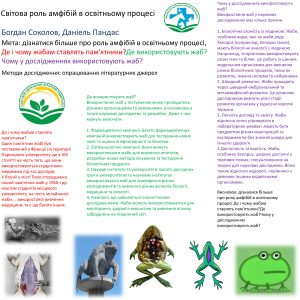


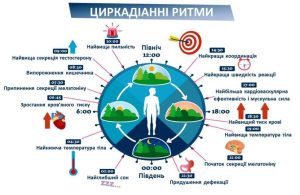
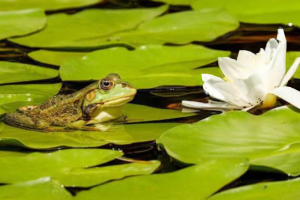

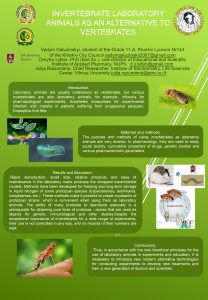 8.
8. 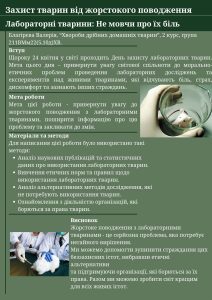
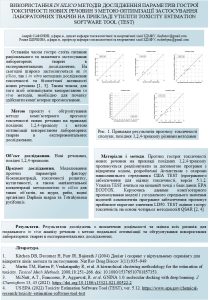 10.
10. 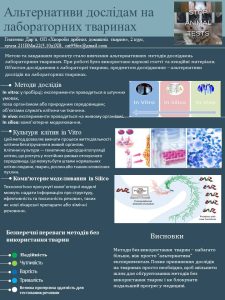 11.
11.  12.
12.